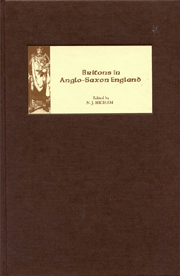Book contents
- Frontmatter
- Contents
- List of Illustrations
- List of Tables
- Contributors
- Dedication
- Acknowledgements
- Abbreviations
- 1 Britons in Anglo-Saxon England: An Introduction
- 2 Anglo-Saxon Attitudes
- 3 Forgetting the Britons in Victorian Anglo-Saxon Archaeology
- 4 Romano-British Metalworking and the Anglo-Saxons
- 5 Invisible Britons, Gallo-Romans and Russians: Perspectives on Culture Change
- 6 Historical Narrative as Cultural Politics: Rome, ‘British-ness’ and ‘English-ness’
- 7 British Wives and Slaves? Possible Romano-British Techniques in ‘Women's Work’
- 8 Early Mercia and the Britons
- 9 Britons in Early Wessex: The Evidence of the Law Code of Ine
- 10 Apartheid and Economics in Anglo-Saxon England
- 11 Welsh Territories and Welsh Identities in Late Anglo-Saxon England
- 12 Some Welshmen in Domesday Book and Beyond: Aspects of Anglo-Welsh Relations in the Eleventh Century
- 13 What Britons Spoke around 400 AD
- 14 Invisible Britons: The View from Linguistics
- 15 Why Don't the English Speak Welsh?
- 16 Place-Names and the Saxon Conquest of Devon and Cornwall
- 17 Mapping Early Medieval Language Change in South-West England
- Index
1 - Britons in Anglo-Saxon England: An Introduction
Published online by Cambridge University Press: 12 September 2012
- Frontmatter
- Contents
- List of Illustrations
- List of Tables
- Contributors
- Dedication
- Acknowledgements
- Abbreviations
- 1 Britons in Anglo-Saxon England: An Introduction
- 2 Anglo-Saxon Attitudes
- 3 Forgetting the Britons in Victorian Anglo-Saxon Archaeology
- 4 Romano-British Metalworking and the Anglo-Saxons
- 5 Invisible Britons, Gallo-Romans and Russians: Perspectives on Culture Change
- 6 Historical Narrative as Cultural Politics: Rome, ‘British-ness’ and ‘English-ness’
- 7 British Wives and Slaves? Possible Romano-British Techniques in ‘Women's Work’
- 8 Early Mercia and the Britons
- 9 Britons in Early Wessex: The Evidence of the Law Code of Ine
- 10 Apartheid and Economics in Anglo-Saxon England
- 11 Welsh Territories and Welsh Identities in Late Anglo-Saxon England
- 12 Some Welshmen in Domesday Book and Beyond: Aspects of Anglo-Welsh Relations in the Eleventh Century
- 13 What Britons Spoke around 400 AD
- 14 Invisible Britons: The View from Linguistics
- 15 Why Don't the English Speak Welsh?
- 16 Place-Names and the Saxon Conquest of Devon and Cornwall
- 17 Mapping Early Medieval Language Change in South-West England
- Index
Summary
THE presence, or absence, of significant numbers of Britons in Anglo-Saxon England has recently been the subject of considerable debate, with scholars in several disciplines offering conflicting opinions. There are a number of key questions to which we would very much like answers. Whether or not there were many Britons within Anglo-Saxon England is just the starting point: if there were large numbers, how did they come to be there, what roles did they perform and what eventually happened to them? If there were only very few, then what became of the sub-Roman population of the lowland zone of the old diocese, and how should we explain particular instances when the presence of Britons is indicated very much later, for example, by place-name or literary evidence? And just what should we understand by the term ‘Britons’, both at different points in the past, and in our present? Should we define this term in racial, ethnic, linguistic and/or religious terms, and what baggage is it carrying? What should we read into Brittones in Bede's Historia ecclesiastica, for example, or Bretwalas and Brettas in the Anglo-Saxon Chronicle? What does walh signify in such place-names as Walton? And when we read in Domesday Book that one Grifin (the Welsh personal name Gruffudd) held Weston (Ches.) in 1066, should we suppose that he was an immigrant from Wales or were ‘Welsh’ names used in the eleventh-century western Midlands, much as they seem to have been in late seventh-century Northumbria and Wessex?
- Type
- Chapter
- Information
- Britons in Anglo-Saxon England , pp. 1 - 15Publisher: Boydell & BrewerPrint publication year: 2007



